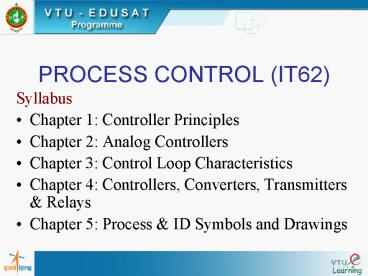PROCESS CONTROL IT62 - PowerPoint PPT Presentation
1 / 27
Title: PROCESS CONTROL IT62
1
PROCESS CONTROL (IT62)
- Syllabus
- Chapter 1 Controller Principles
- Chapter 2 Analog Controllers
- Chapter 3 Control Loop Characteristics
- Chapter 4 Controllers, Converters, Transmitters
Relays - Chapter 5 Process ID Symbols and Drawings
2
- Textbooks
- Process Control Inst. Technology (7th Edn) by
C.D.Johnson, Pearson Education Pub.2003. For
Chapter 1, 2 and 3 - Instrument Engineers Handbook Vol. 1-Process
Measurement, Vol. 2-Process Control, by Bela J.
Liptak, Chilton Book Company. For Chapter 4 5
3
COURSE OVERVIEW
- The course provides a fundamental knowledge to
instrumentation engineer regarding the
implementation of process control techniques in
the process industries. - The course also provides a basic knowledge about
process instrumentation drawing symbols and
diagrams.
4
COURSE OBJECTIVE
- To make instrumentation technology students to
become familiar with process control techniques
tools. - At the end of this course you will be in a
position to measure, acquire, control tune the
process parameters in process industries.
5
INTRODUCTION TO PROCESS CONTROL
- Process
- In general, process constitutes a sequence of
events in which a raw material will be converted
into finished product. - Any system composed of dynamic variables,
usually involved in manufacturing production
operations.
6
- Control
- The methods/techniques to force parameters or
variables in the environment / process to have
specific values. - Control System
- All the elements necessary to accomplish the
control objective i.e. regulation of some
parameters to have specific or desired values
7
- Process Control
- It deals with the elements and methods of
control system operations used in industry to
control industrial processes.
8
PROCESS CONTROL PRINCIPLE
- Objective of process control is to regulate the
value of some quantity. - Regulation It means to maintain a quantity or
variable at some desired value regardless of
external influences.
9
Process An Example-Level of Liquid in a tank
- Qout gt Qin Level drops
- Qout lt Qin Level rises
10
Human Aided Control
- Definition
- Example Control of liquid level in a tank
11
Automatic Control System
- Definition
- Example Control of liquid level in a tank
12
Some Definitions Related to Process Control
- Controlled Variable The process variable
regulated by process control loop. - Controlling Variable The process variable
changed by the final control element under the
command of controller to effect regulation of
controlled variable. - Setpoint The desired value of a controlled
variable in process control loop.
13
- Error The algebraic difference between the
measured value of variable and setpoint. - Controller The element in a process control loop
that evaluates error of the controlled variable
and initiates corrective action by a signal to
controlling variable. - Dynamic variable The process variable that can
change from moment to moment because of unknown
sources.
14
ELEMENTS OF PROCESS CONTROL
- Process
- Measurement
- Error Detector
- Controller
- Control Element
15
PROCESS CONTROL BLOCK DIAGRAM
p Controller output c Controlled variable b
measured value of c e Error signal r Set
point u Controlling variable Fig. Block
diagram of basic process control loop.
16
Example
Fig. Physical diagram for flow process control
system
17
Final Control Element
I/P Converter, Actuator, Valve
Controller
(Error Detector)
(Controller)
Pipe Flow
r
Process
Orifice plate, DP Cell, P/I Converter
Measurement
Fig. Block diagram for flow process control
system.
18
ANALOG DATA REPRESENTATION
- Analog Standards for representing range of
variable in Process Control Systems - Current Signal 4 to 20 mA
- Pneumatic Signal 3 to 15 psi (20 to 100kPa)
19
Why Current Signal?
- Current is used instead of voltage because the
system is then less dependent on load.
Fig. Transmission of current signal is
independent of line resistance
20
FINAL CONTROL OPERATION
Fig. Elements of Final Control Operation
21
Chapter-1CONTROLLER PRINCIPLES
22
OBJECTIVES
- Define understand the process characteristics,
process system parameters - Describe the discontinuous and continuous
controller modes - Describe the composite controller modes
- Compare and differentiate discontinuous and
continuous controller modes, and their advantages
applications.
23
PROCESS CHARACTERISTICS
- Selection of controller modes is a function of
process characteristics. - Important Process Characteristics
- Process Equation
- Process Load
- Process Lag
- Self Regulation
24
Example
- Process Parameters
- TL Liquid temperature (controlled variable)
- QA Input flow rate
- QB Output flow rate
- TA Ambient Temp.
- TO Inlet temperature of liquid
- TS Steam Temp.
- QS Steam flow rate (Controlling variable)
Fig. Control of liquid temperature in a tank by
process control
25
1. Process Equation
- The process equation is a function which
describes the process and provides the
information about other process parameters which
influence the controlled variable. - For liquid temperature control the process
equation is - TL f (QA, QB, QS, TA, TS, TO)
26
2. Process Load
- The process load refers to set of all process
parameters excluding the controlled variable. - Nominal Set
- Nominal Load
- Nominal value
- Process Load Change
- Transient Load Change Example
27
3. Process Lag
- Process lag refers to the time consumed by the
process itself to bring the controlled variable
to setpoint value during load change. Example
4. Self-regulation
- Some processes adopt to stable value without
being regulated via process control loop.































